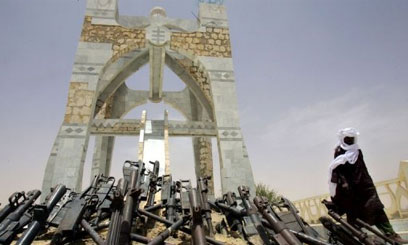BAMAKO, April 3 – Three months ago, U2 frontman Bono made a surprise appearance at a popular music festival in the dunes outside Timbuktu.
Today, the tourists are long gone and ominous black flags planted by jihadists flap in the city whose heyday as an ancient trading hub and intellectual centre has suddenly been supplanted with a new identity as the centre of a chaotic rebellion.
The northern Mali city has traditionally been secular, with girls going to school bareheaded and the market selling animist talismans outlawed by Islam.
But on Monday, women were forced to wear veils and trousers after the Islamist group Ansar Dine asserted their control of the town and chased out Tuareg rebels with whom they had captured it from the coup-stricken Malian state on Sunday.
It’s not the first time the legendary city has seen tumult.
Founded between the 5th and 11th Centuries by Tuareg desert nomads, Timbuktu became a meeting point between north, south and west Africa and a melting pot of black Africans, Berber, Arab and Tuareg desert nomads.
The trade of gold, salt, ivory and books made it the richest region in west Africa and it attracted scholars, engineers and architects from around Africa, growing into a major centre of Islamic culture by the 14th Century.
Some 25,000 students were said to attend the University of Sankore at the time.
The legend of Timbuktu began in 1324, when the Emperor of the Mali empire Mansa Mussa (1307-1332) made a pilgrimage to Mecca via Cairo with 60,000 porters, each carrying three kilogrammes of pure gold which he said came from Timbuktu.
This amount of gold caused the Egyptian currency to lose its value, according to the UN cultural agency UNESCO, and put Timbuktu on the map as a mysterious African city of gold.
Timbuktu grew to become a metaphor for remoteness, with the saying “from here to Timbuktu” evoking images of a place so distant many do not know it exists at the edge of the Sahara desert in Mali.
Upon his return, Mussa built the famous Mosque of Djingareyber, one of the city’s three great mosques, still standing 700 years on.
From the jewel of the ancient Malian Empire (1230-1600), which once spanned most of the western bulge of Africa, Timbuktu then fell back into Tuareg hands and later formed part of the Songhai Empire which was one of the world’s largest Islamic empires.
Intellectual activity flourished and hundreds of thousands of ancient manuscripts remain as testament to sub-Saharan Africa’s golden age covering mathematics, chemistry, physics, astronomy, medicine history and geography.
These riches, the remaining architecture and the legend had made Timbuktu one of the main draws for visitors to Mali despite its decline since 1591, when the Moroccan army plundered the city, burned libraries and killed scholars.
Many explorers unsuccessfuly tried to reach Timbuktu, including Scottish doctor Mungo Park, who disappeared while sailing the Niger river alone in 1805 after his entire expedition team died along the way.
About two decades later, the Geographical Society of Paris was said to have offered a reward to the first European to visit Timbuktu and live to tell the tale.
Modern Timbuktu is an impoverished town sinking into the desert where youth unemployment is high.
It now sits at a crossroads between Tuareg rebels, radical Islamists, drug traffickers and Al-Qaeda in the Islamic Maghreb which has made it a no-go area for tourists.
The various groups of rebels have seized much of the north of modern-day Mali which shares a similar rich history as Timbuktu, like the city of Gao (capital of the Songhai empire).
The Tuareg rebels want independence, conflicting with the Islamist’s desire for sharia law, while Al-Qaeda and various other criminal groups want to deepen their hold and ensure nothing interrupts a booming drug and weapons trade.
Fighters have been aided by weapons brought back by the Tuareg, who fought for slain dictator Moamer Kadhafi in Libya.
In 2006, he made himself an imam of Timbuktu, declaring it his favourite Malian town in an ostentatious ceremony.










































